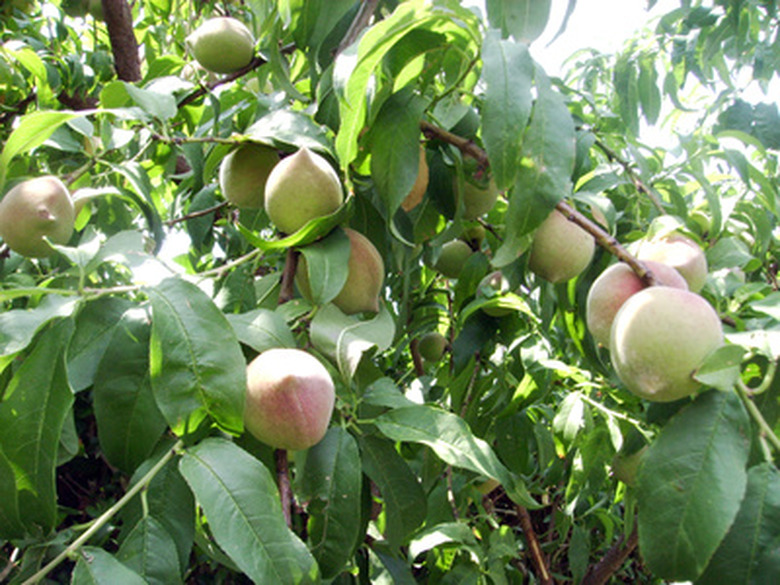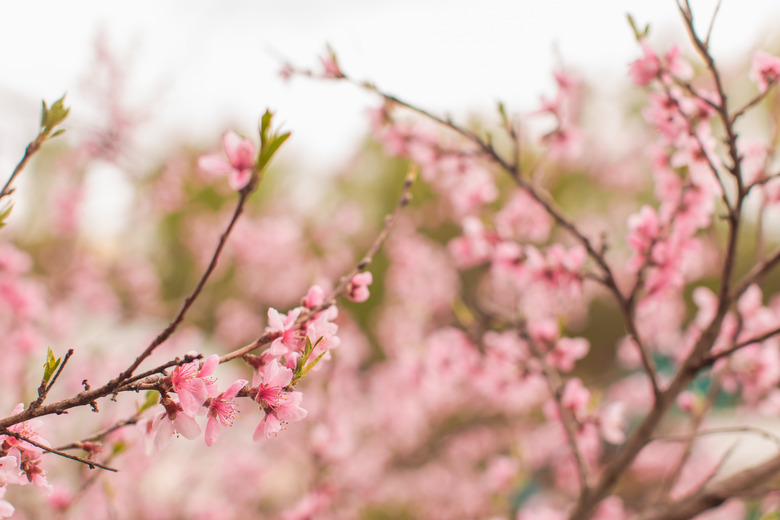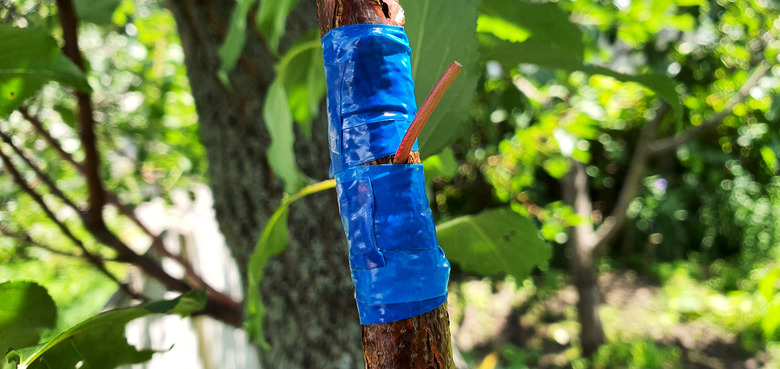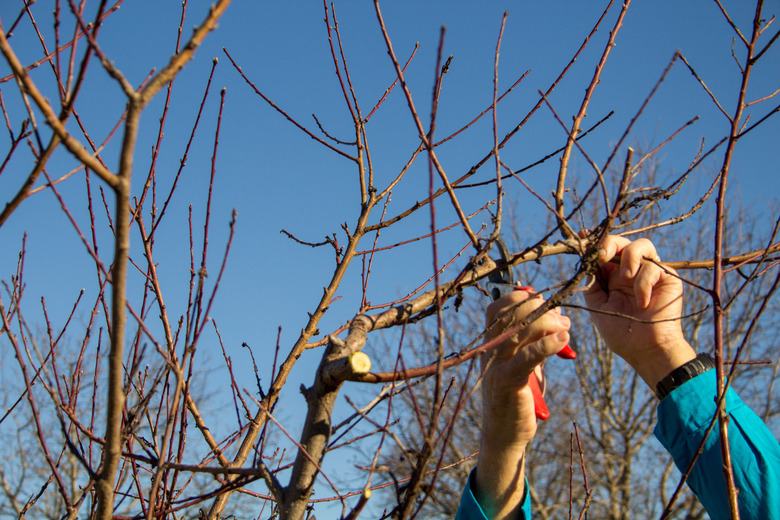How To Clone Peach Trees By Grafting
Peach trees (Prunus persica) are among the best-loved fruit trees for home orchards. Hundreds of peach cultivars have been developed with differing fruit quality, hardiness and disease resistance, most of which grow well within USDA plant hardiness zones 4 to 9. Although peach trees are widely available in most plant nurseries, some curious gardeners opt to propagate them at home.
The only way to propagate peach cultivars successfully is to use clonal propagation methods, such as cleft grafting. Cleft grafting is the best propagation method for peach trees, because it faithfully reproduces the fruiting characteristics of the original parent tree while also providing a good root system.
Learning how to cleft graft peach trees can be challenging for less experienced gardeners, but it is doable with the right direction.
About Grafting Peach Trees
Perhaps the most important aspect of grafting peach trees is choosing the right rootstock and the right scion. The scion is the part of the tree that will flower and bear fruit, so it is selected based on the quantity and quality of its fruit. The rootstock forms the root system of the grafted peach tree and can enhance cold hardiness, adaptability and disease resistance.
Choosing a rootstock that is compatible with the native soil is key, especially when growing peach trees. For instance, a rootstock made of Lovell (Prunus persica 'Lovell,' zones 4 to 8) is well adapted to areas with alkaline soil, while Nemaguard (Prunus persica 'Nemaguard,' zones 4 to 8) performs well in sandy, acidic soil.
Once an appropriate rootstock is found, locate a scion that has fruit production and quality that you would enjoy growing in your garden. There are hundreds of clingstone and freestone peach varieties from which to choose, including popular cultivars such as Redhaven (Prunus persica 'Redhaven,' zones 5 to 8) and Contender (Prunus persica 'Contender'), a slightly more cold-tolerant variety that grows in zones 4 to 8.
Grafting Peach Trees
Grafting peach trees should be done when temperatures are between 75 and 80°F, which is the optimal temperature range for a successful union between rootstock and scion, but the process actually starts during the dormant season.
1. Gather your scion wood in late winter or early spring when the tree is dormant. Take a 2- to 8-inch-long cutting with a thickness of 1/4 to 1/2 inch. A scion with at least three buds is preferable. Cut it just below the bottom bud using a sharp knife. 2. Wrap your scion pieces in moist paper towel and place them inside a plastic zipper bag. Store them in the refrigerator for up to a few weeks while outdoor temperatures warm up. 3. Prepare the rootstock. Select a branch for each scion. Look for a straight branch that is 1 to 2 inches thick with smooth bark and no sign of damage or disease. Cut the branch straight across using a sharp knife. 4. Create a cleft or split in the rootstock branch using your knife. Set the sharp edge of your knife across the center of the cut end of the branch. Press the knife into the wood to create a cleft or split that is 1 1/2 inches deep. 5. Prepare your scion. Shape the cut end of your scion branch. Slice down either side of the cut end of your scion to create a wedge-like shape or a shape similar to the head of a flathead screwdriver. 6. Slip the scion into the cleft in your rootstock. Look for the cambium layer in the scion and the rootstock, which is the pale greenish layer of growth just inside the bark. Line up the cambium layer in the scion with the cambium layer in the rootstock, which is where the two parts will start exchanging nutrients and water as they heal together. 7. Seal the graft using grafting wax or grafting tape, which will help keep out rainwater while also helping to keep the scion from drying out. Wrap it thoroughly but not too tightly. 8. Check the graft often and get rid of any insects that have gathered around the graft point.
Peach tree propagation using grafts will yield good results quickly. New growth can appear as soon as just a few weeks after grafting, but it can also take a bit longer depending on the growing conditions.
Tip
Wipe down your grafting knife with household disinfectant to kill off any pathogens that might damage the scion or rootstock.
Starting Peach Tree Cuttings
Cuttings are not the best option for growing a peach tree. However, learning how to root a peach tree cutting is useful, because it will allow you to grow rootstock for grafting. Growing your own rootstock to propagate fruit trees is a more advanced aspect of plant propagation, but it is doable with patience and good preparation.
1. Hardwood cuttings taken in winter make the best rootstock. Peach cuttings should be taken from healthy branches from the outer edge of the tree that received plenty of direct sunlight throughout its life. 2. Take 10- to 12-inch-long cuttings that are 1 to 2 inches thick. Cut the bottom directly below a growth node and cut off the tip of the cutting 1/2 to 1 inch above a node. Use a thin-bladed saw to cut thicker cuttings and sturdy hand pruners for thinner cuttings. 3. The rootstock cuttings can be potted immediately or stored in the refrigerator for a week or two. To store rootstock cuttings, dip the ends in wax and bundle them together. Wrap them in moist peat moss or newspaper inside polyethylene plastic bags and store them in the refrigerator until the start of the growing season. 4. Start rootstock cuttings by treating the basal end, which is the end where you cut it off the tree branch, with rooting hormone. Dip the cutting in IBA rooting hormone powder. IBA is an abbreviation for indole-3-butyric acid, which is how it is often written on product labels.
Gardeners who are starting rootstock for their home garden are typically only starting a handful of hardwood cuttings to propagate a few fruit trees for their personal use, so the cuttings can be potted individually rather than in large bundles like commercial growers.
1. Pot each peach tree cutting in a 1-gallon nursery pot filled with a moistened mix of half potting soil and half coarse sand or perlite. Bury the bottom half of the cutting in the potting mix. 2. Bottom heat helps speed up and increase rooting, so set the pots on a propagation mat set to 65 to 70°F. Keep the potting mixture moist but not soggy until it starts to root. 3. Prune off the top of the cutting before the leaves open, leaving only one bud. Make the pruning cut just above the bud.
Cutting-propagated peach rootstock is ready for use as soon as it has rooted. Grafting on the scion should be done as soon as possible before the rootstock starts to form leaves and buds.
References
- Penn State University: Grafting the Peach Tree
- North Carolina State University Cooperative Extension: Prunus persica
- Texas A&M AgriLife Extension: Recommended Fruit, Nut And Berry Cultivars For North Central Texas
- UC Davis Fruit and Nut Research & Information Center: Stone Fruit Propagation by Cuttings



